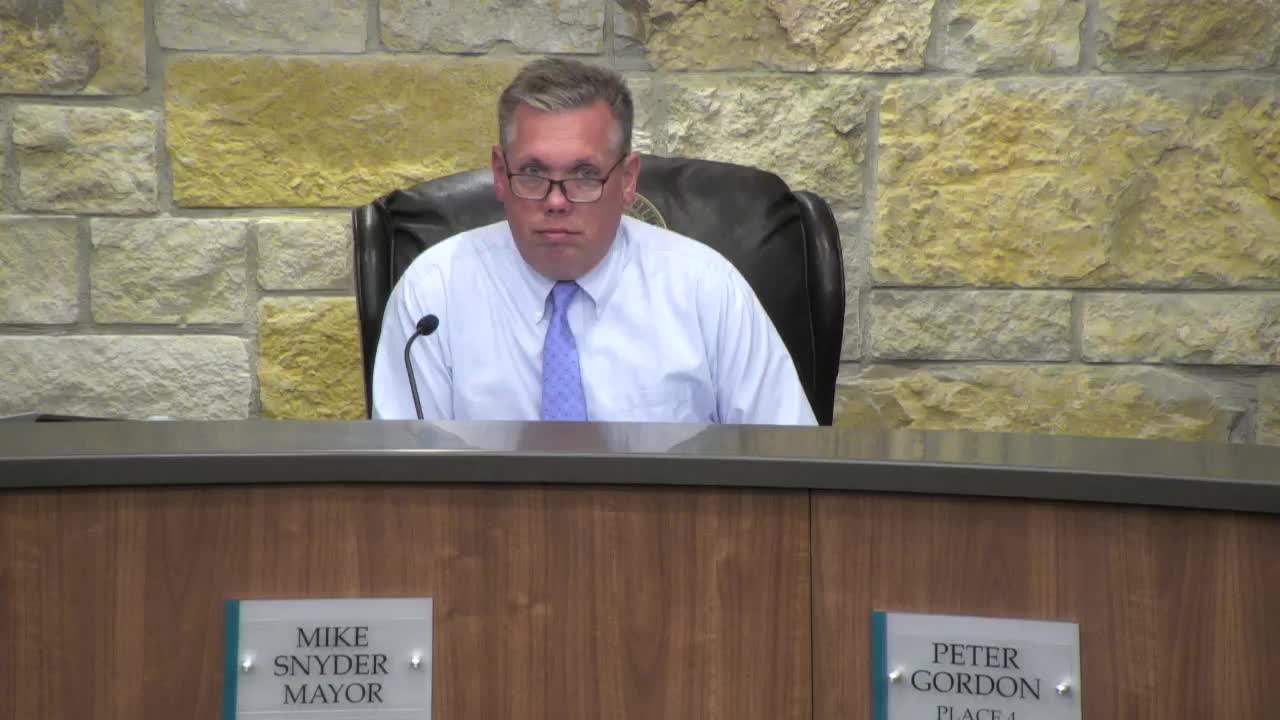Legends of Hutto drainage project cleared for bid; city tracks up to $800,000 shortfall
October 02, 2025 | Hutto, Williamson County, Texas
This article was created by AI summarizing key points discussed. AI makes mistakes, so for full details and context, please refer to the video of the full meeting. Please report any errors so we can fix them. Report an error »

HUTTO, Texas — City consultants told the Hutto City Council on Oct. 2 the first phase of the Legends of Hutto drainage improvement project is ready to be advertised for bids, with work expected to start in late 2025 or January 2026 and a construction duration estimated at about six months.
Angela Points of WSB, the project engineer, summarized the design for Phase 1: expand detention capacity at a neighborhood pond with a retaining wall and outlet weir; regrade and convert undersized earthen ditches to reinforced concrete channels; and add “pilot” or trickle channels to help velocity and reduce siltation. “We are going to provide that to the contractor,” Points said, noting engineers produced a 3‑D model to help bidders and constructors estimate quantities and construct in tight spaces.
Why it matters: the neighborhood currently experiences surface flow across yards and slow, low‑velocity ditches that back up and flood backyards. The design aims to increase conveyance capacity by 50–75 percent in key channels and reduce recurring backyard and ditch flooding.
Timeline and funding
- WSB delivered signed and sealed plans in late September; city staff plans to advertise this month and use a qualifications-weighted selection (Competitive Sealed Proposal) to favor experienced contractors for the tight work.
- Construction could be awarded in December and begin in January 2026; Point’s team estimated about six months for linear construction because crews must work from the pond northward.
- Funding on hand tallied in the presentation was approximately $3.7 million; preliminary estimates indicate likely costs near $4.5 million, leaving an estimated shortfall of about $800,000 that staff said they will address after bids are returned. Points and city staff said there are options to reduce scope — for example, shortening the extent of one concrete pilot channel — if bids exceed available funding.
Neighborhood outreach and tradeoffs
- Staff and consultants said they coordinated with the homeowners association and prioritized HOA‑identified channels; the contractor will be required to plan for weather delays and erosion control, and the city will circulate notices and updates to the HOA.
- WSB emphasized the contractor will need to work in tight spaces, that no private property easements are required for the current design and that the project avoids a longer FEMA process by limiting pond discharges through the retaining wall design.
What’s next
City staff will advertise the project, receive bids and report back to council. If bids come in higher than budgeted, staff told council they can reduce selected scope items and present recommended adjustments or additional funding sources to council for approval.
Speakers quoted in this article include Angela Points, project engineer for WSB, and Matt Recker, city engineer.
Angela Points of WSB, the project engineer, summarized the design for Phase 1: expand detention capacity at a neighborhood pond with a retaining wall and outlet weir; regrade and convert undersized earthen ditches to reinforced concrete channels; and add “pilot” or trickle channels to help velocity and reduce siltation. “We are going to provide that to the contractor,” Points said, noting engineers produced a 3‑D model to help bidders and constructors estimate quantities and construct in tight spaces.
Why it matters: the neighborhood currently experiences surface flow across yards and slow, low‑velocity ditches that back up and flood backyards. The design aims to increase conveyance capacity by 50–75 percent in key channels and reduce recurring backyard and ditch flooding.
Timeline and funding
- WSB delivered signed and sealed plans in late September; city staff plans to advertise this month and use a qualifications-weighted selection (Competitive Sealed Proposal) to favor experienced contractors for the tight work.
- Construction could be awarded in December and begin in January 2026; Point’s team estimated about six months for linear construction because crews must work from the pond northward.
- Funding on hand tallied in the presentation was approximately $3.7 million; preliminary estimates indicate likely costs near $4.5 million, leaving an estimated shortfall of about $800,000 that staff said they will address after bids are returned. Points and city staff said there are options to reduce scope — for example, shortening the extent of one concrete pilot channel — if bids exceed available funding.
Neighborhood outreach and tradeoffs
- Staff and consultants said they coordinated with the homeowners association and prioritized HOA‑identified channels; the contractor will be required to plan for weather delays and erosion control, and the city will circulate notices and updates to the HOA.
- WSB emphasized the contractor will need to work in tight spaces, that no private property easements are required for the current design and that the project avoids a longer FEMA process by limiting pond discharges through the retaining wall design.
What’s next
City staff will advertise the project, receive bids and report back to council. If bids come in higher than budgeted, staff told council they can reduce selected scope items and present recommended adjustments or additional funding sources to council for approval.
Speakers quoted in this article include Angela Points, project engineer for WSB, and Matt Recker, city engineer.
View full meeting
This article is based on a recent meeting—watch the full video and explore the complete transcript for deeper insights into the discussion.
View full meeting
